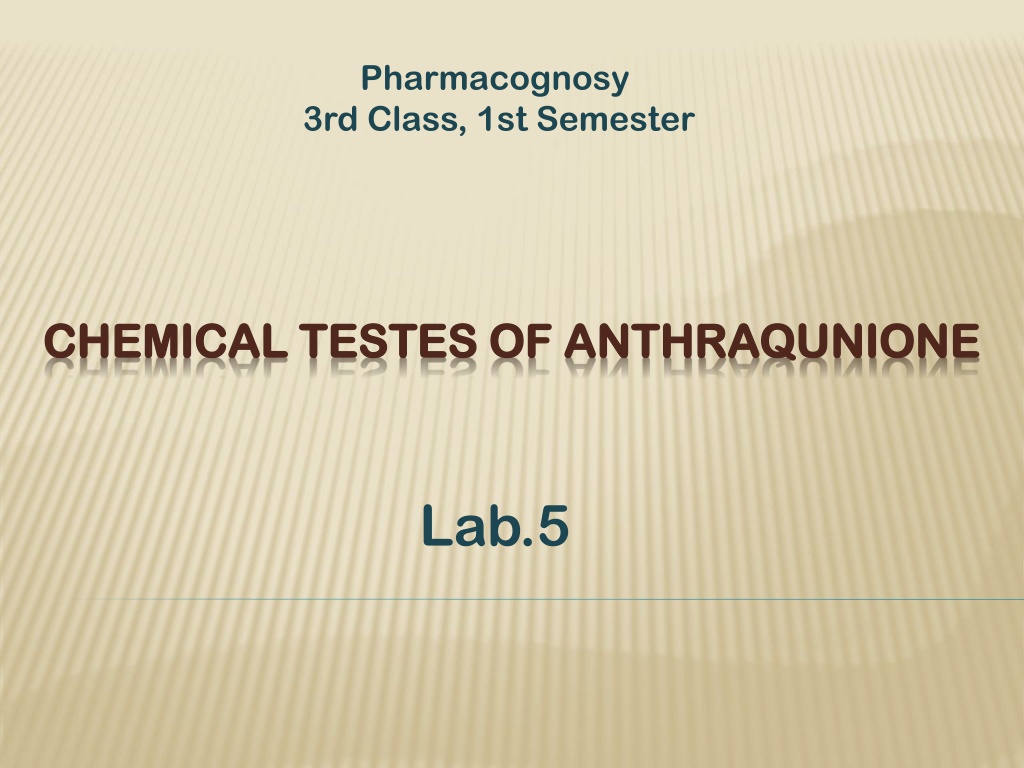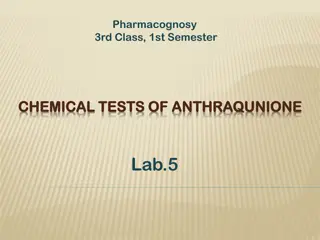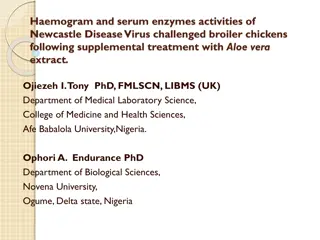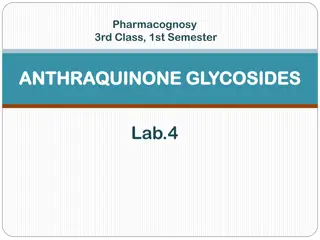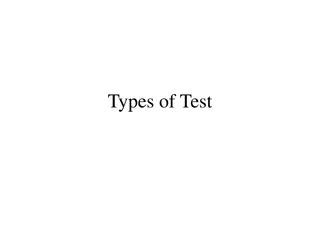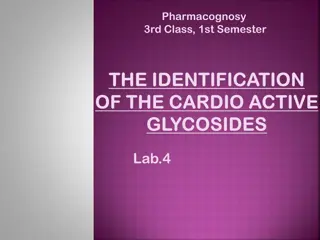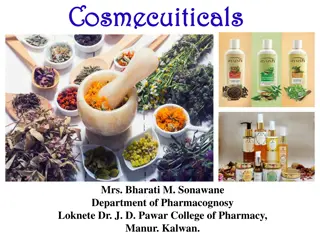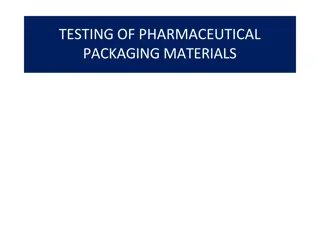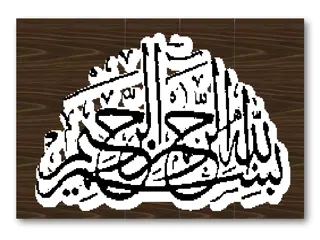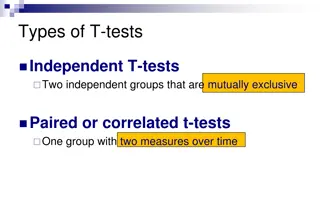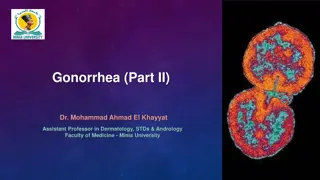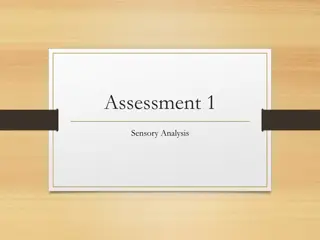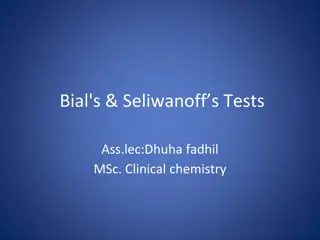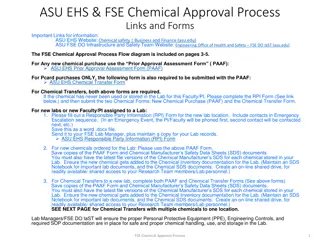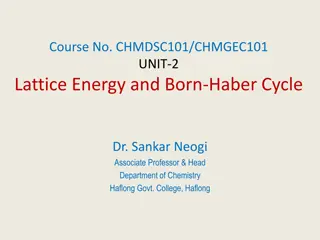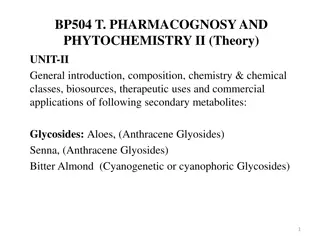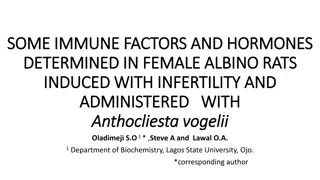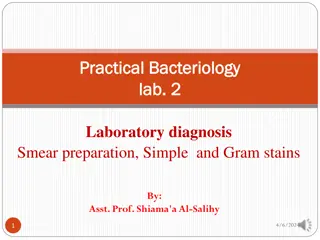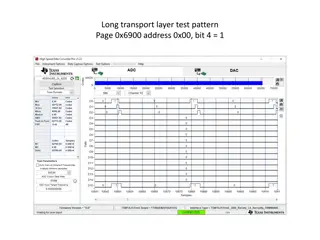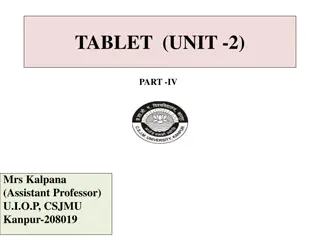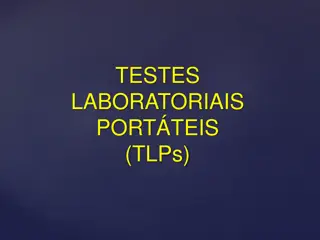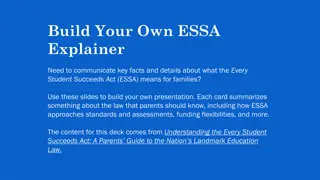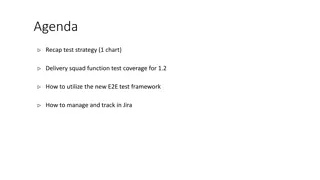Chemical Tests for Anthraquinone in Aloe Vera Extract
This pharmacognosy lab experiment focuses on identifying anthraquinone glycosides in aloe vera extract through chemical tests like Schonteten's reaction with borax and the bromine test for aloin. Special reagents like nitric acid and nitrous acid are also used for specific identification. The procedures and results are detailed, shedding light on the chemical composition of aloe vera.
Download Presentation

Please find below an Image/Link to download the presentation.
The content on the website is provided AS IS for your information and personal use only. It may not be sold, licensed, or shared on other websites without obtaining consent from the author. Download presentation by click this link. If you encounter any issues during the download, it is possible that the publisher has removed the file from their server.
E N D
Presentation Transcript
Pharmacognosy 3rd Class, 1st Semester CHEMICAL TESTES OF ANTHRAQUNIONE CHEMICAL TESTES OF ANTHRAQUNIONE Lab.5
Binomial name: Binomial name:- - Family: Family: - - Xanthorrhoeaceae Aloe vera Aloe vera
A A- - GENERAL GENERAL REACTION REACTION Boil 1gm of the crude drugs (aloe) with 100ml of water. Filter the solution and use this solution for the following tests: 1) 2) 1) SCHONTETENS REACTION (BORAX TEST) 1) SCHONTETENS REACTION (BORAX TEST) 2) BROMINE TEST FOR ALOIN 2) BROMINE TEST FOR ALOIN
1) SCHONTETENS REACTION (BORAX TEST) SCHONTETENS REACTION (BORAX TEST) AIM AIM To identify the Anthraquinone glycosides in general Equipment and reagents Equipment and reagents 1) Test tube 2) Small beaker 3) Water bath 4) Borax Procedure Procedure 1) Take 5 ml of the extract. 2) Add 0.2 gm of the borax and heat until dissolved. 3) Pour a few drops of the liquid into a test tube nearly full in water. Results Results A green fluorescence is produced. Discussion Discussion This green fluorescence is due to aloe emodin anthranol form barbaloin by hydrolysis with borax giving this reaction.
2) BROMINE TEST FOR ALOIN 2) BROMINE TEST FOR ALOIN AIM AIM T To identify the Anthraquinone glycosides in general Equipment and reagents Equipment and reagents Test tube Bromine solution 1) 2) Procedure Procedure Take 2ml of the extract Add an equal volume or an excess of freshly prepared solution of the bromine. Record the color 1) 2) 3)
B B- - SPECAL REAGENTS SPECAL REAGENTS 1) Nitric acid test 1) Nitric acid test Aim Aim S Specific identification of the Anthraquinone glycosides. Equipment and reagents Equipment and reagents Test tube Concentrated nitric acid 1) 2) Procedure Procedure Take 5ml of solution. Add 2ml of concentrated nitric acid. Record the results pale brown. 1) 2) 3)
2 2- -NITROUS ACID TEST (SPECIFIC FOR ISOBARBALOIN) NITROUS ACID TEST (SPECIFIC FOR ISOBARBALOIN) Aim Aim Specific identification of the Anthraquinone glycosides(isobarbaloin ) Equipment and reagents Equipment and reagents Test tube Sodium nitrite Glacial acetic acid 1) 2) 3) Procedure Procedure Take a few mills from an aqueous solution Add a few crystals of sodium nitric acid and a drop of glacial acetic acid , shake well. Record the results brown. 1) 2) 3)
3 3) CUPRALOIN TEST FOR ISOBARBALOIN (KLIGS REACTION) ) CUPRALOIN TEST FOR ISOBARBALOIN (KLIGS REACTION) AIM AIM To identity test for Curacao aloe. Equipment and reagents Equipment and reagents Small beaker Water bath 10%coppersulphate solution Sodium chloride Procedure Procedure 1) Mix 5ml of the filtrate with 5ml of the water 2) Add: A drop of 10% copper sulphate solution 0.5gm of sodium chloride 1ml of alcohol, warm gently. 3) Record the results. 1) 2) 3) 4) A. B. C.
4 )BORNTRAGERS TEST 4 )BORNTRAGERS TEST Aim Aim To identity test for Anthraquinone. Equipment and reagents Equipment and reagents 1) Separatory funnel 2) Test tube 3) Dilute acid 4) Benzene 5) Dilute ammonia 10% Procedure Procedure 1) Take 10 ml of the solution extract (fraction A) 2) Add few drops of dilute acid 3) Place the mixture in a separatory funnel and extract with 10 ml of benzene for 1 minute. 4) Separate the upper layer and place in a test tube (aqueous glycoside layer). Take the lower benzene layer (fraction B and C) and shake it with dilute ammonia (10%) Results Results Pink color will be produced which is very clear with fraction C Discussion Discussion The benzene extracts the aglycone, and with ammonia, forms Anthraquinone salts, which have, pink color.
RHUBARB RHUBARB TEST FOR IDENTITY TEST FOR IDENTITY The Anthraquinone may readily be separated from powdered rhubarb by micro-sublimation. Borntragers test (is carried out as above procedure) 1) 2) TEST FOR PURITY TEST FOR PURITY Extract a small amount of the powdered rhubarb with ether Add a few drops of this extract on a piece of filter paper. When dry, add a few drops of boric acid solution and one drop of dilute HCL, a red color develops which after treating with ammonia becomes blue to bluish- black. Moisten a small amount of the powdered drug with a cooled mixture of equal parts of concentrated H2SO4 and alcohol. A reddish-violet color should develop. 1) 2) 3) 4)
Binomial name: Binomial name:- - Rheum rhabarbarum Family : Family :- - Polygonaceae
